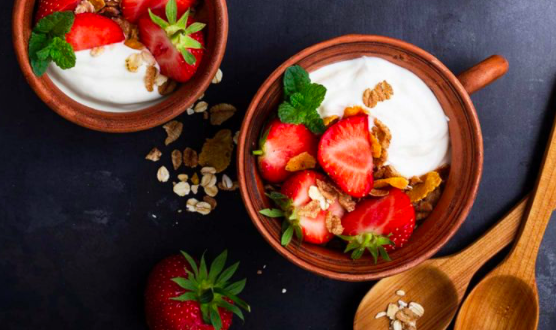|
Getting the kids off to school in the morning is hectic enough. And trying to find time to 
make—and make kids eat—a healthy breakfast can be the biggest challenge of the morning. But it's a step too important to skip. “Feeding your children a healthy breakfast provides their brains with the nutrition they need to pay attention and learn,” says Kristi King, M.P.H., R.D., senior pediatric dietitian at the Texas Children’s Hospital. “Making sure they eat well in the morning helps set them up for success.”
Numerous studies have reinforced the benefits of a healthy breakfast for kids. A 2013 analysis of 36 studies, published in the journal Frontiers in Human Neuroscience, found that regular breakfast eaters are more likely to exhibit “on-task behavior”—such as paying attention, being alert, and being able to concentrate—in the classroom.
The same analysis concluded that eating breakfast consistently is associated with improved school performance, including better grades and test scores. Other studies have also found that kids who routinely eat breakfast tend to have healthier diets overall and are less likely to be overweight.
What Makes a Healthy Breakfast?
“You want to make sure breakfast includes at least these two major nutrients: lean protein and fiber,” says King. “The combination will help your child feel full and help sustain blood sugar levels so he or she can concentrate better and have more energy.”
Good protein sources include yogurt, nuts or seeds (including nut or seed butters), eggs, and low-fat or part-skim cheeses. For fiber, focus on fruits and vegetables and whole grains (such as whole-wheat toast, oatmeal, or whole-grain cereal).
What you want to avoid is feeding your child a breakfast loaded with sugars. Sources include sugary cereals (some that are marketed to children contain more sugars per serving than a serving of cookies), yogurt, breakfast bars, and pastries. Look for a cereal that's made with whole grains and contains a minimum of added sugars—the lower the better, but no more than 8 grams per serving. “Added sugars will contribute to spikes and drops in blood sugar that can affect concentration,” says King. If you need to add some sweetness to unsweetened cereal or yogurt, mix in fresh fruit instead of something sugary.
You should also go easy on the fruit juice. The American Academy of Pediatrics recommends that children eat their fruit, not drink it. “It’s easy to overdo it on calories when you’re drinking juice as compared to eating fruit” says Amy Keating, R.D., a nutritionist at Consumer Reports. “Plus the fruit contains fiber, which the juice does not have.” According to new AAP guidelines, children ages 4 to 6 shouldn’t drink more than 4 to 6 ounces of fruit juice a day. Those age 7 and older shouldn’t have more than 8 ounces. And if your child is overweight, the organization suggests you not give it to him or her at all.
Tips for Getting Breakfast Ready in a Rush
With a little planning, feeding your kids a healthy breakfast before school doesn’t need to be a morning-wrecker. There are several steps you can take to make the a.m. routine go more smoothly and send your kids off to school well-nourished.
Make Extra
“If you have time over the weekend, cook and freeze a bunch of breakfast foods that you can just pull out, microwave, and eat all week long,” says Toby Amidor, R.D., author of "Smart Meal Prep for Beginners." Some of her freezer favorites include:
• Egg muffins: Bake eggs mixed with cheese and veggies in muffin tins. Remove and store in the refrigerator (for up to a week) or freezer.
• Pancakes: Anytime you make pancakes, cook up several extras and freeze them. (Substitute whole-grain flour for at least half the flour in your pancake recipe to increase the fiber content.) Defrost in a toaster oven or microwave, then spread with nut butter or top with yogurt and fresh fruit.
• Smoothie packs: Stash individual smoothie makings in plastic bags in your freezer. In the morning just dump one in the blender with some milk or plain yogurt to make a healthy smoothie.
Prep the Night Before
“I set the table, premeasure all my dry ingredients if I’m making something like pancakes or waffles, even set out pans and cooking utensils,” Amidor says. “If I can just walk into the kitchen and immediately start cooking, it shaves off several minutes.” Other night-before tricks include:
• Make overnight oats: Mix ½ cup of oats, ½ cup of milk (dairy, nut, or soy), and ½ cup yogurt (if you like) in individual jars, and place in the fridge overnight. In the morning, just stir and heat in the microwave.
• Prep an array of toppings (nuts, dried fruit, seeds, berries): Store them in individual containers. In the morning your kids can mix in their favorites to customize their cereal, oatmeal, or yogurt.
• Cut up fresh fruit and veggies: Have fruit and vegetables pre-chopped or shredded so that it doesn’t take any extra time to add a boost of nutrients to pancake batter, cereal, or scrambled eggs.
Mix Up Your Meals
“If your kids claim to hate breakfast foods, it’s okay to let them choose alternatives,” says Keating. “There’s no nutritional reason you need cereal, eggs, or toast in the morning.” She does suggest always including fresh or frozen fruit (with no sugar added), however. “Kids don’t eat enough fruit, and it’s easy to send them off to school with a banana or an apple.” Add a side of fruit to the following healthy options:
• Half a grilled cheese on whole-wheat bread.
• Hummus and veggies with a whole-wheat pita.
• A smaller portion of last night’s dinner leftovers.
This article originally published on Finance.Yahoo.com Sally Wadyka
Posted Friday, September 21 2018 11:00 AM
Tags : Healthy Breakfast for Kids
|